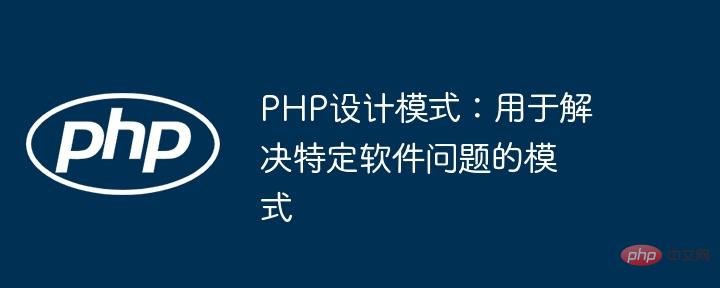 Backend Development
Backend Development
 PHP Tutorial
PHP Tutorial
 PHP Design Patterns: Patterns used to solve specific software problems
PHP Design Patterns: Patterns used to solve specific software problems
PHP Design Patterns: Patterns used to solve specific software problems
PHP design patterns provide known solutions to common problems in software development. Common pattern types include creational (such as factory method pattern), structural (such as decorator pattern) and behavioral (such as observer pattern). Design patterns are particularly useful when solving repetitive problems, improving maintainability, and promoting teamwork. In e-commerce systems, the observer pattern can realize automatic updates between shopping cart and order status. Overall, PHP design patterns are an important tool for creating robust, scalable, and maintainable applications.

PHP Design Patterns: Solutions to Specific Software Problems
A design pattern is a known solution using To solve common problems in software development. With the rich set of built-in design patterns in PHP, developers can efficiently create robust and maintainable applications.
Understanding design patterns
Design patterns are usually classified into creative, structural and behavioral. Here are some common examples:
- Creative patterns: Singleton, Factory Method, Builder
- Structural patterns: Decorator, Facade , Proxy
- Behavioral pattern: Strategy, Command, Observer
Simple factory method pattern
Factory method Pattern is a creational design pattern that defines an interface for creating objects, and the specific logic of creating objects is determined by subclasses. This makes the process of creating objects more flexible and customizable.
Code Example:
interface VehicleInterface
{
public function createVehicle();
}
class CarFactory implements VehicleInterface
{
public function createVehicle()
{
return new Car();
}
}
class BikeFactory implements VehicleInterface
{
public function createVehicle()
{
return new Bike();
}
}
// 使用工厂
$carFactory = new CarFactory();
$car = $carFactory->createVehicle();
$bikeFactory = new BikeFactory();
$bike = $bikeFactory->createVehicle();When to use design patterns?
Design patterns are not always appropriate to use. The following are scenarios to consider using design patterns:
- Solve repetitive problems, thereby improving code reusability.
- Enhance the maintainability of your code by organizing its logic into clear patterns.
- Improve teamwork efficiency and code standardization.
Practical case: Observer mode in e-commerce system
In an e-commerce system, Shopping cart should be added by the user Or promptly update order status when deleting items. Observer pattern provides the perfect solution.
In PHP, the SplSubject and SplObserver classes provide a basic implementation of the observer pattern.
class Cart implements SplSubject
{
private $observers = [];
private $items = [];
public function attach(SplObserver $observer)
{
$this->observers[] = $observer;
}
public function detach(SplObserver $observer)
{
if (in_array($observer, $this->observers)) {
unset($this->observers[array_search($observer, $this->observers)]);
}
}
public function notify()
{
foreach ($this->observers as $observer) {
$observer->update($this);
}
}
public function addItem($item)
{
$this->items[] = $item;
$this->notify();
}
public function removeItem($item)
{
$key = array_search($item, $this->items);
if ($key !== false) {
unset($this->items[$key]);
$this->notify();
}
}
}
class OrderStatusObserver implements SplObserver
{
public function update(SplSubject $subject)
{
if ($subject instanceof Cart) {
echo "Order status has been updated.\n";
}
}
}
// 使用观察者模式
$cart = new Cart();
$orderStatusObserver = new OrderStatusObserver();
$cart->attach($orderStatusObserver);
// 模拟添加和删除商品
$cart->addItem('Item A');
$cart->removeItem('Item B');Conclusion
PHP design patterns are powerful tools that can help developers solve common software development problems. By understanding and applying these patterns, you can create applications that are robust, scalable, and maintainable.
The above is the detailed content of PHP Design Patterns: Patterns used to solve specific software problems. For more information, please follow other related articles on the PHP Chinese website!

Hot AI Tools

Undresser.AI Undress
AI-powered app for creating realistic nude photos

AI Clothes Remover
Online AI tool for removing clothes from photos.

Undress AI Tool
Undress images for free

Clothoff.io
AI clothes remover

AI Hentai Generator
Generate AI Hentai for free.

Hot Article

Hot Tools

Notepad++7.3.1
Easy-to-use and free code editor

SublimeText3 Chinese version
Chinese version, very easy to use

Zend Studio 13.0.1
Powerful PHP integrated development environment

Dreamweaver CS6
Visual web development tools

SublimeText3 Mac version
God-level code editing software (SublimeText3)

Hot Topics
 CakePHP Project Configuration
Sep 10, 2024 pm 05:25 PM
CakePHP Project Configuration
Sep 10, 2024 pm 05:25 PM
In this chapter, we will understand the Environment Variables, General Configuration, Database Configuration and Email Configuration in CakePHP.
 PHP 8.4 Installation and Upgrade guide for Ubuntu and Debian
Dec 24, 2024 pm 04:42 PM
PHP 8.4 Installation and Upgrade guide for Ubuntu and Debian
Dec 24, 2024 pm 04:42 PM
PHP 8.4 brings several new features, security improvements, and performance improvements with healthy amounts of feature deprecations and removals. This guide explains how to install PHP 8.4 or upgrade to PHP 8.4 on Ubuntu, Debian, or their derivati
 CakePHP Date and Time
Sep 10, 2024 pm 05:27 PM
CakePHP Date and Time
Sep 10, 2024 pm 05:27 PM
To work with date and time in cakephp4, we are going to make use of the available FrozenTime class.
 CakePHP File upload
Sep 10, 2024 pm 05:27 PM
CakePHP File upload
Sep 10, 2024 pm 05:27 PM
To work on file upload we are going to use the form helper. Here, is an example for file upload.
 CakePHP Routing
Sep 10, 2024 pm 05:25 PM
CakePHP Routing
Sep 10, 2024 pm 05:25 PM
In this chapter, we are going to learn the following topics related to routing ?
 Discuss CakePHP
Sep 10, 2024 pm 05:28 PM
Discuss CakePHP
Sep 10, 2024 pm 05:28 PM
CakePHP is an open-source framework for PHP. It is intended to make developing, deploying and maintaining applications much easier. CakePHP is based on a MVC-like architecture that is both powerful and easy to grasp. Models, Views, and Controllers gu
 CakePHP Creating Validators
Sep 10, 2024 pm 05:26 PM
CakePHP Creating Validators
Sep 10, 2024 pm 05:26 PM
Validator can be created by adding the following two lines in the controller.
 CakePHP Working with Database
Sep 10, 2024 pm 05:25 PM
CakePHP Working with Database
Sep 10, 2024 pm 05:25 PM
Working with database in CakePHP is very easy. We will understand the CRUD (Create, Read, Update, Delete) operations in this chapter.





